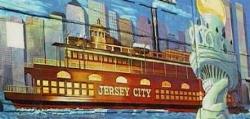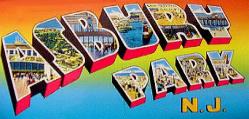 |  |  |
|
| ||
 |  |  |
 |  |  |
|
| ||
 |  |  |
|
|
George H. Cook,
STATE GEOLOGIST.
Edited by GET NJ
Copyright 2003
The work of
tracing the straight line, and making the proper surveys and computations
on the position of the monuments, has been done by Prof. Ed. A. Bowser,
during the present summer, and his report is presented here.
"New Brunswick, N. J,, Aug. 28, 1874.
"DR. GEO. H. COOK,Dear Sir,
"I have the honor to submit the following report of the survey of the Northern Boundary of New Jersey, made in the months of July and August of the present year.
I was instructed to run a straight line from the Tristates-rock at the northwest terminus of the Boundary to the eastern terminus at the Hudson River; and to locate the present monuments and describe the mile-stones. My instructions required me also to find the variation of the needle at different points, to ascertain where there was local attraction, to examine the topography of the Country in the neighborhood of the line, and to take barometric heights."
To assist me in this work I fortunately obtained the services of Mr. Jas. K, Barton, of the class of 1871, Rutgers Scientific School, and a careful and accurate Surveyor. I was assisted also by several of the students of the Scientific School. The instrument used was an 8-inch theodolite which was loaned by the Superintendent of the U. S. Coast Survey. This instrument was placed in charge of Mr. Barton.
"The work was begun at the northwest terminus of the Boundary, The instrument was set up on the Tri-states-rock and the angle between the meridian and the Boundary as computed by the Coast Survey was turned off. From this station a point on our line was determined on the westerly edge of the summit of the Blue Mountain. The instrument was then moved forward to this point, and after running to the easterly edge of the summit we sighted to the top of Pochuck Mountain, a distance of about ten miles. From the station on the Pochuck we sighted to the top of Warwick Mountain, a distance of eight miles. From this station we could see our back stations on the Pochuck and the Blue Mountain in the same vertical plane; the latter being eighteen miles off. Three sights more brought us to the high mountain west of Suffern's station, and distant from our station on Warwick Mountain eleven miles; the two intermediate stations being on Rough Mountain and Cedar Pond Mountain. From the station near Suffern's we sighted to a point eight miles ahead, which was nine miles from the Hudson River; and from this last station we reached a point on the Palisades, about three-quarters of a mile from the Hudson River. From this point we could look back and see our station at the nine-mile stone, and also the one west of Suffern's, in the same vertical plane; the latter being seventeen miles off. Three sights more brought us to the Hudson River, which we reached at a distance of 48 63-lOOths feet north of the eastern terminus of the Boundary. With a very few exceptions our sights were several miles in length, and all of them were made with several repetitions and with the utmost care. The offsets were then computed in order to locate exactly the straight line joining the cast and west ends of the Boundary. We then ran from the Hudson back to the Delaware, and located the present Boundary by measuring the distance of each mile-stone fiom our line and subtracting the offsets. These distances, together with the present Boundary and the straight line just run, are shown on the map which accompanies this report. With the exception.of stations 10, 15, 22, 26, 27, 30, 31, 34, 36, 41, 43, 46, 47 and 48, thirteen in all, there is a stone monument standing at every mile, with the Words New York and New Jersey and the number of miles the stone is from the west edge of the Hudson river, cut in it. Stations 15, 22, 26, 36, 41, 46, 47 and 48 were located by ascertaining from farmers living in the neighborhood where the line had "always run" at these points. At many of the stations were piles of stones, while at others the wood was cut on one side of the line and standing on the opposite side. At stations 15 and 41 the monuments are broken down and lying a short distance away; Station 10,is lying down having been plowed up this spring. At station 26 the monument is probably below the surface of Greenwood lake, as it was placed in 1774 on the western edge, and the water is now several feet higher than it was then. At stations 31, 34 and 43 are blazed trees which are said to be on the line, and are so recognised in deeds, -- At station 30 neither the stone monument nor the line could be found. It will be seen on the map that the present boundary is crooked, swinging down into New Jersey, and quite regular except in the mountain region between the 16th and 29th milestones; and that midway it deviates from the straight line about 2400 feet.
"We found the variation of the needle at the east end to be about 2 deg. more than at the west end, and the variation about the 40th mile stone is 1 deg. less than at Tristates-rock.
"At a number of places in the mountain region between the 16th and 29th mile stones, at the Pochuck Mt., and also on the Palisades, there was some local attraction.
"It becomes interesting to know why the line we have just run should differ so much from the present Boundary. The line we have just run is a straight line; in other words it is an arc of a great circle, which is the shortest distance between two points on the surface of a sphere. The present Boundary which was run in 1774 was run with the compass, and therefore would be approximately a rhumb line, and the shorter the sights the closer the approximation: that is, it would everywhere have the same course. Now if there had been no variation of the needle or if the variation had been everywhere the same, the line run would have been approximately a true rhumb line, which would differ a little from an arc of a great circle; it would be slightly curved, swinging down into New Jersey. But because there was a variation of the needle, and because this variation -- although different in amount from what it now is must have been about 2 deg. more at the east than at the west end, the line run must have been approximately a magnetic rhumb line which would curve much more than a true rhumb line; that is it would swing down into New Jersey much more than a true rhumb line would. And because there was local attraction at many points the curve would be likely to have irregularities in it, notwithstanding the care that might be taken to eliminate all errors: for example the irregularity between the 18th and 19th milestones. Up to the 18th the distances of the stones from the straight line increase pretty regularly by a little less than a hundred feet whereas the distance of the 19th mile-stone from the line exceeds that of the 18th by 469 feet.
"To ascertain how much the present "Boundary differs from a magnetic rhumb line on the supposition that the variation of the needle when the line was run was 2 deg. more at the east than at the west end, I have made several computations. The following are the results:
"The true course at the east end of an arc of a great circle running from the terminal point on the Hudson River to the Tri-states-rock on the Delaware is N. 58 deg. 43 min. 06 seconds W.
"The true course of a true rhumb line connecting the same points; that is a line cutting every astronomical meridian at the same angle is about N. 58 deg., 57 min. 11 seconds W.
"The true course of a magnetic rhumb line, that is a line cutting every magnetic meridian at the same angle, owing to the change of variation of the needle between the east and west ends is about N. 59 deg., 50 min, 11 seconds W.
"The present magnetic bearing of this line, is about N. 51 deg. W.
"The middle point of a true rhumb line would be south of the middle point of an arc of a great circle by 1.3 seconds, or 133 feet.
"The middle point of a magnetic rhumb line would be south of the middle point of a true rhumb line by 16.6 seconds, or 1702 feet.
"The middle point of a magnetic rhumb line would be south of the middle point of the arc of a great circle by 17.9 seconds, or 1835 feet.
"By comparing this magnetic thumb line with the present "Boundary," as represented on the map, it will be seen that with the exception of the part through the mountain region between the 16th and 29th mile-stones, the Boundary coincides tolerably well with a magnetic rhumb line, The conclusion therefore is, if there had been no local attraction in 1774, the Surveyors, Clinton and Dennis, instead of running a straight line would have run a magnetic rhumb line from the Hudson River to the Delaware. But because there was local attraction at different points, the line then run and marked has in it several irregularities; and this is probably the reason why the present crooked line forms the "Northern Boundary of New Jersey."
 Your Ancestors' Story |
 Bruce Springsteen's Jersey Shore Rock Haven! |

|
UrbanTimes.com |